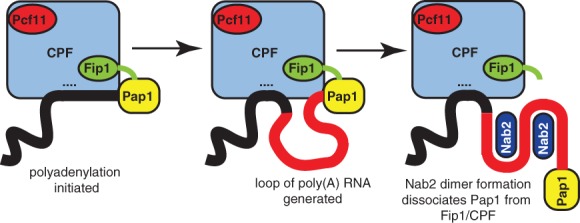Figure 6.

Function of ScNab2 in polyadenylation termination. Illustration of how the formation of an ScNab2 dimer could terminate polyadenylation by decreasing the flexibility of the poly(A) chain (red) so that poly(A) polymerase (Pap1—yellow) is dissociated from the cleavage and polyadenylation factor (CPF) so that it ceases to function processively and dissociates. The growing poly(A) chain (red) is held at its 5′ end by the transcript that is bound to the CPF (….) and at its 3′ end by Pap1 so that a flexible loop of poly(A) RNA is formed as polyadenylation progresses. When the poly(A) tail is sufficiently long, Nab2 binds and the resulting dimerization reduces the flexibility of the RNA so that Pap1 is forced to dissociate from the CPF and Fip1, after which it ceases to be processive and so dissociates from the poly(A) tail, terminating polyadenylation.
